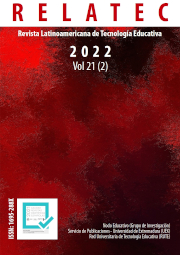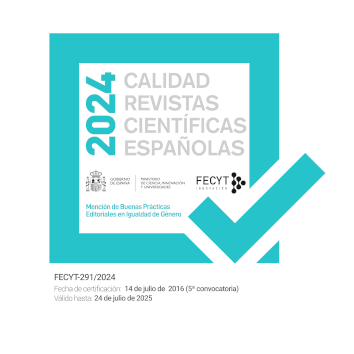El Uso de la Teoría de la Autodeterminación en el Contexto de la Gamificación. Una revisión de la literatura
DOI:
https://doi.org/10.17398/1695-288X.21.2.59Palabras clave:
Revisión de Literatura, Autodeterminación, Motivación Intrínseca, Motivación Extrínseca, Aprendizaje Basado en JuegosResumen
La gamificación puede definirse como el uso de elementos de juego fuera de su escenario original, con el fin de transformar ciertas actividades en procesos interesantes y atractivos. Sin embargo, para que esto ocurra, se requiere una planificación estratégica en el desarrollo de un entorno gamificado, centrándose principalmente en la motivación, ya que esto puede ayudar al sujeto a permanecer en la actividad. La teoría de la autodeterminación se concibió para estudiar los vínculos entre la personalidad, la motivación humana y el funcionamiento óptimo. Presenta dos tipos de motivación, intrínseca y extrínseca. A partir de estos constructos se empezó a trabajar la teoría en el contexto de la gamificación. A partir de la combinación de estos temas, se elaboró un mapa para comprender cómo se utiliza la TED en el contexto de la gamificación. Para la búsqueda de datos, se consideraron 11 bases de datos electrónicas. Para este estudio, también se tuvieron en cuenta los artículos y trabajos publicados en los anales. Estos fueron sometidos a criterios de exclusión, y la base de datos final resultó en 62 estudios publicados entre 2014 y 2020 y analizados con el software Iramuteq. Se encontró que el SDT asociado a la gamificación comenzó a ser explorado en 2014 y posteriormente se desarrollaron otros trabajos. Se trata de un ámbito que ha ido creciendo en los últimos años, vinculado a áreas como la educación, la salud y el trabajo.
Descargas
Referencias
Ahn, S. J., Johnsen, K., & Ball, C. (2019). Points-based reward systems in gamification impact children’s physical activity strategies and psychological needs. Health Education & Behavior, 46(3), 417-425.https://doi.org/10.1177/1090198118818241
Attig, C., & Franke, T. (2019). I track, therefore I walk–Exploring the motivational costs of wearing activity trackers in actual users. International Journal of Human-Computer Studies, 127, 211-224. https://doi.org/10.1016/j.ijhcs.2018.04.007
BasirianJahromi, R., Bigdeli, Z., Haidari, G., & HajiYakhchali, A. (2017). Designing and applying librarygame website software and investigating its impact on self-determination factors of library users. Iranian Journal of Information Processing Management, 33(1), 361-386.
Bissolotti, K., Nogueira, H. G., & Pereira, A. T. C. (2014). Potencialidades das mídias sociais e da gamificação na educação a distância. Renote, 12(2). https://doi.org/10.22456/1679-1916.53511
Bovermann, K., & Bastiaens, T. J. (2020). Towards a motivational design? Connecting gamification user types and online learning activities. Research and Practice in Technology Enhanced Learning, 15(1), 1-18.
Camargo, B. V. (2005) Alceste: Um programa informático de análise quantitativa de dados textuais. In Moreira, A. S. P., Camargo, B. V., Jesuíno, J. C., Nóbrega, S. M. (Eds.). Perspectivas teórico-metodológicas em representações sociais. Editora da UFPB. pp. 511–539.
Corepal, R., Best, P., O’Neill, R., Kee, F., Badham, J., Dunne, L., ... & Hunter, R. F. (2019). A feasibility study of ‘The StepSmart Challenge’to promote physical activity in adolescents. Pilot and feasibility studies, 5(1), 1-15.
Creswell, J. W. (ed). (2007). Projeto de pesquisa: métodos qualitativo, quantitativo e misto. 2. ed. Artmed.
Chen, X., Li, X., Lee, S. Y. C., & Chu, S. K. (2018). Re‐examining students' reading experience in a gamified context from a self‐determination perspective: A multiple‐case study. Proceedings of the Association for Information Science and Technology, 55(1), 66-75. https://doi.org/10.1002/pra2.2018.14505501008
Dimitriadou, S. (2017). Designing and implementing a gamified system based on STD in the Moodle learning platform. Proc. INTED2017, 3707-3714.
Deci, E. L., & Ryan, R. M. (2000). The ‘what” and “why” of goal pursuits: human needs and the self-determination of behavior. Psychological Inquiry, 11(4), 227–268. https://doi.org/10.1207/S15327965PLI1104_01
Deterding, S. (2016). Contextual autonomy support in video game play: a grounded theory. In Proceedings of the 2016 chi conference on human factors in computing systems (pp. 3931-3943). https://doi.org/10.1145/2858036.2858395
Frost., R. D, Matta., V., & MacIvor., E. (2015). Assessing the efficacy of incorporating game dynamics in a learning management system. Journal of Information Systems Education, 26(1), 59–70. http://jise.org/Volume26/n1/JISEv26n1p59.pdf
Garrett, S. D., & Young, R. (2018). Health Care Gamification: A Study of Game Mechanics and Elements. Technology, Knowledge and Learning, 24, 341–353. https://doi.org/10.1007/s10758-018-9353-4.
Gurjanow, I., Oliveira, M., Zender, J., Santos, P. A., & Ludwig, M. (2019). Mathematics trails: Shallow and deep gamification. International Journal of Serious Games, 6(3), 65-79. https://doi.org/10.17083/ijsg.v6i3.306
Grau, P., Naderi, B., & Kim, J. (2018). Personalized Motivation-supportive Messages for Increasing Participation in Crowd-civic Systems. Proceedings of the ACM on Human-Computer Interaction, 2(CSCW), 1-22. https://doi.org/10.1145/3274329
Handani, S. W., & Kusuma, T. P. P. (2018, November). Comparing Learning Media Applications Using Gamification Theory. In 2018 3rd International Conference on Information Technology, Information System and Electrical Engineering (ICITISEE) (pp. 37-42). IEEE. https://doi.org/10.1109/ICITISEE.2018.8720994
Haque, M. S., Jämsä, T., & Kangas, M. (2017). A Theory-Driven System Model to Promote Physical Activity in the Working Environment with a Persuasive and Gamified Application. In DDGD@ MindTrek (pp. 37-44).
Hew, F. K., Huang, B., Chu, K. W. S., & Chiu, D. K. W. (2015). Engaging Asian students through game mechanics: Findings from two experiment studies. Computers & Education, 92(93), 221–236. https://doi.org/10.1016/j.compedu.2015.10.010
He, X., Yan, H., & Song, X. (2019, December). The Effects of Rewards Mechanisms On the Game-based Chinese Learning System. In 2019 12th International Symposium on Computational Intelligence and Design (ISCID) (Vol. 1, pp. 113-116). IEEE. https://doi.org/10.1109/ISCID.2019.00032
Hew, K. F., Huang, B., Chu, K. W. S., & Chiu, D. K. (2016). Engaging Asian students through game mechanics: Findings from two experiment studies. Computers & Education, 92, 221-236. https://doi.org/10.1016/j.compedu.2015.10.010
Ilhan, A. (2018, July). Motivations to Join Fitness Communities on Facebook: Which Gratifications Are Sought and Obtained?. In International Conference on Social Computing and Social Media (pp. 50-67). Springer, Cham. https://doi.org/10.1007/978-3-319-91485-5_4
Jozani, M. M., Maasberg, M., & Ayaburi, E. (2018, July). Slayers vs Slackers: An Examination of Users’ Competitive Differences in Gamified IT Platforms Based on Hedonic Motivation System Model. In International Conference on Learning and Collaboration Technologies (pp. 164-172). Springer, Cham. https://doi.org/10.1007/978-3-319-91152-6_13
Kasurinen, J., & Knutas, A. (2018). Publication trends in gamification: A systematic mapping study. Computer Science Review, 27, 33-44. https://doi.org/10.1016/j.cosrev.2017.10.003
Kalat, J. W. (2011). Introduction to Psychology, (International edition). Wadsworth Cengage Learning.
Kaleta., J. P., Kettinger, & W. J., Zhang, C. (2014). Achieving business goals with gamification: An informational and motivational perspective. 20th Americas Conference on Information Systems, AMCIS. https://aisel.aisnet.org/cgi/viewcontent.cgi?article=1565&context=amcis2014
Kapp, K. M. (2012). The gamification of learning and instruction: game-based methods and strategies for training and education. Pfeiffer. https://absel-ojs-ttu.tdl.org/absel/index.php/absel/article/view/40
Kitchenham, B. (2007). Guidelines for performing Systematic Literature Reviews in Software Engineering, Version 2.3, EBSE Technical Report EBSE-2007-01, Keele University and University of Durham.
Korn, O. & Tietz, S. (2017). Strategies for Playful Design when Gamifying Rehabilitation. A Study on User Experience. Petra ’17, 209–214. http://doi.org/10.1145/3056540.3056550
Klock, A. C. T., de Carvalho, M. F., Rosa, B. E., & Gasparini, I. (2014). Análise das técnicas de Gamificação em Ambientes Virtuais de Aprendizagem. Renote, 12(2).https://doi.org/10.22456/1679-1916.53496
Kim, J., & Castelli, DM (2021). Efeitos da Gamificação na Mudança Comportamental na Educação: Uma Meta-análise. Jornal Internacional de Pesquisa Ambiental e Saúde Pública , 18 (7), 3550. MDPI AG. http://dx.doi.org/10.3390/ijerph18073550
Lamprinou, D., & Paraskeva, F. (2015). Gamification design framework based on SDT for student motivation. International Conference on Interactive Mobile Communication Technologies and Learning (IMCL), 406–410. http://doi.org./10.1109/IMCTL.2015.7359631
Lo, C. K., & Hew, K. F. (2020). A comparison of flipped learning with gamification, traditional learning, and online independent study: the effects on students’ mathematics achievement and cognitive engagement. Interactive Learning Environments, 28(4), 464-481. https://doi.org/10.1080/10494820.2018.1541910
Lemus, B. A., & Pinto, R. (2014). Designing, building and preliminary results of “Cerebrex”, a serious educational videogame. In Proceedings Conference and Trends (InPACT) (pp. 1-5).
Mahmud, S. N. D., Husnin, H., & Tuan Soh, T. M. (2020). Teaching presence in online gamified education for sustainability learning. Sustainability, 12(9), 3801. https://doi.org/10.3390/su12093801
Marins, D. R. (2013). Um processo de Gamificação Baseado na Teoria da Autodeterminação. [Dissertação de Mestrado, COPPE, Universidade Federal do Rio de Janeiro]. https://www.cos.ufrj.br/uploadfile/1387465246.pdf
Menezes, C. C. N., & Bortoli, R. (2018). Gamificação: surgimento e consolidação. C&S – São Bernardo do Campo, 40(1), 267–297. https://doi.org/10.15603/2175-7755/cs.v40n1p267-297
Nacke, L., Deterding, S. (2017). The maturing of gamification research. Computers in Human Behavior, 71, 450–-454. http://doi.org/10.1016/j.chb.2016.11.062
Nurmi, J., Knittle, K., Ginchev, T., Khattak, F., Helf, C., Zwickl, P., ... & Haukkala, A. (2020). Engaging users in the behavior change process with digitalized motivational interviewing and gamification: development and feasibility testing of the precious app. JMIR mHealth and uHealth, 8(1), e12884. http://doi.org/10.2196/12884
Perryer, C., Celestine, N. A., Scott-Ladd, B., & Leighton, C. (2016). Enhancing workplace motivation through gamification: Transferrable lessons from pedagogy. The International Journal of Management Education, 14(3), 327-335. https://doi.org/10.1016/j.ijme.2016.07.001
Pilkington, C. (2018). A playful approach to fostering motivation in a distance education computer programming course: Behaviour change and student perceptions. The International Review of Research in Open and Distributed Learning, 19(3). https://doi.org/10.19173/irrodl.v19i3.3664
Poffo, M., & Agostini Volani, E. (2018). Gamificação para motivar o aprendizado. CIET:EnPED, . Recuperado de https://cietenped.ufscar.br/submissao/index.php/2018/article/view/268
Plangger, K., Campbell, C., Robson, K., & Montecchi, M. (2019). Little rewards, big changes: Using exercise analytics to motivate sustainable changes in physical activity. Information & Management, 103216.https://doi.org/10.1016/j.im.2019.103216
Proulx, J. N., & Romero, M. (2015, December). Game and Learning Mechanics Under the Perspective of Self-determination Theory for Supporting Motivation in Digital Game Based Learning. In International Conference on Games and Learning Alliance (pp. 141-150). Springer, Cham. https://doi.org/10.1007/978-3-319-40216-1_15
Prabowo, R., Sucahyo, Y. G., Gandhi, A., & Ruldeviyani, Y. (2019, October). Does gamification motivate gig workers? a critical issue in ride-sharing industries. In 2019 International Conference on Advanced Computer Science and information Systems (ICACSIS) (pp. 343-348). IEEE. https://doi.org/10.1109/ICACSIS47736.2019.8979938
Ratinaud, P. (2009). Iramuteq: Interface de R pour les Analyses Multidimensionnelles de Textes et de Questionnaires [Softuware de Computador]. http://www.iramuteq.org
Romano, M., Díaz, P., & Aedo, I. (2016, October). Emergency management and smart cities: Civic engagement through gamification. In International Conference on Information Systems for Crisis Response and Management in Mediterranean Countries (pp. 3-14). Springer, Cham. https://doi.org/10.1007/978-3-319-47093-1_1
Rutledge, C., Walsh, C. M., Swinger, N., Auerbach, M., Castro, D., Dewan, M., ... & Chang, T. P. (2018). Gamification in action: theoretical and practical considerations for medical educators. Academic Medicine, 93(7), 1014-1020. https://doi.org/10.1097/ACM.0000000000002183
Schöbel, S. & Söllner, M. (2016). How to Gamify Information Systems – Adapting Gamification to Individual User Preferences. Twenty-Fourth European Conference on Information Systems (ECIS). Istanbul, Turkey. http://pubs.wi-kassel.de/wp-content/uploads/2016/07/JML_553.pdf
Shi, L., Cristea, A. I., Hadzidedic, S., & Dervishalidovic, N. (2014). Contextual Gamification of Social Interaction – Towards Increasing Motivation in Social E-learning. The 13th International Conference on Web-based Learning (ICWL2014), 116–122. https://doi.org/10.1007/978-3-319-09635-3_12
Tang, J., & Prestopnik, N. R. (2017). Effects of framing on user contribution: Story, gameplay and science. Faculty Articles Indexed in Scopus. 530. https://digitalcommons.ithaca.edu/scopus_articles/530
Tolentino, A. N., & Roleda, L. S. (2019, January). Gamified physics instruction in a reformatory classroom context. In Proceedings of the 10th International Conference on E-Education, E-Business, E-Management and E-Learning (pp. 135-140). https://doi.org/10.1145/3306500.3306527.
Tolks, D., Lampert, C., Dadaczynski, K., Maslon, E., Paulus, P., & Sailer, M. (2020). Spielerische Ansätze in Prävention und Gesundheitsförderung: Serious Games und Gamification. Bundesgesundheitsbl Gesundheitsforsch Gesundheitsschutz, 63(6), 698-707.
Descargas
Publicado
Número
Sección
Licencia
Los autores/as que publiquen en esta revista aceptan las siguientes condiciones:
1. Los autores/as conservan los derechos de autor y ceden a la revista el derecho de la primera publicación, con el trabajo registrado con la licencia Creative Commons Reconocimiento-NoComercial-SinObraDerivada 4.0 International (CC BY-NC-ND), que permite a terceros utilizar lo publicado siempre que mencionen la autoría del trabajo y a la primera publicación en esta revista.
2. Los autores/as pueden realizar otros acuerdos contractuales independientes y adicionales para la distribución no exclusiva de la versión del artículo publicado en esta revista (p. ej., incluirlo en un repositorio institucional o publicarlo en un libro) siempre que indiquen claramente que el trabajo se publicó por primera vez en esta revista.
3. Se permite y recomienda a los autores/as a publicar su trabajo en Internet (por ejemplo en páginas institucionales o personales) antes y durante el proceso de revisión y publicación, ya que puede conducir a intercambios productivos y a una mayor y más rápida difusión del trabajo publicado (vea The Effect of Open Access).









